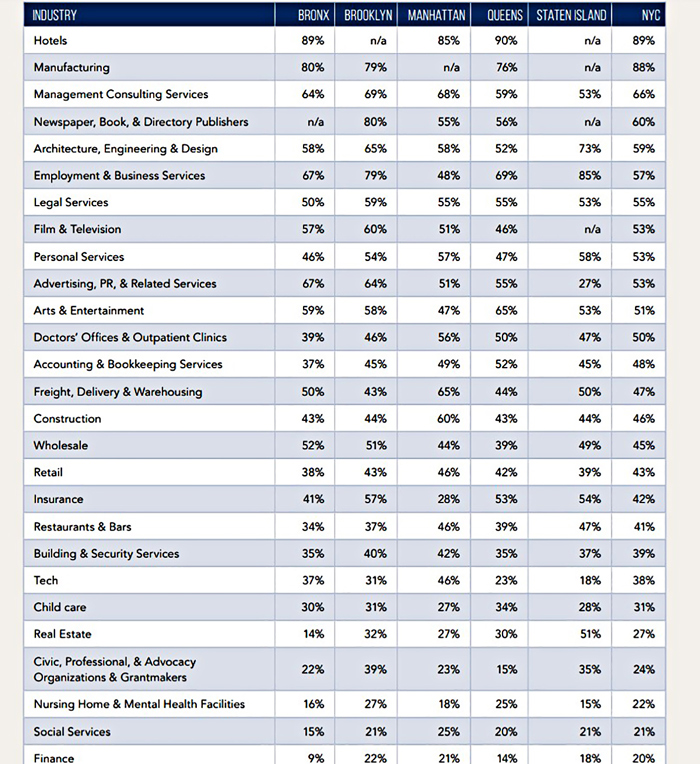Courtesy of Comptroller Stringer’s Office
The chart shows the share of eligible employer businesses that received a PPP loan, by industry and borough.
By Forum Staff
New York City lags far behind in its share of eligible businesses that received a Paycheck Protection Program loan, according to a recently released analysis by City Comptroller Scott Stringer. Barely 12 percent of the more than 1.1 million employee-based and non-employer businesses in the city received a PPP loan compared to more sparsely populated and less economically impacted states such as North Dakota, South Dakota, Nebraska, and Iowa, where more than 20 percent of businesses received a loan. The findings also showed notable disparities between boroughs and industries receiving PPP loans, with non-profits getting minimal support through the program.
Stringer’s analysis also found that of the 120,863 loans distributed to New York City employers as of June 30, the Bronx fared the worst: with a meager 40 percent of Bronx employee-based businesses being PPP recipients compared to 48 percent in Queens; 53 percent in Brooklyn, 52 percent in Manhattan, and 50 percent on Staten Island.
Leading the way were North Dakota (24 percent), South Dakota (24 percent), Nebraska (22 percent), Iowa (20 percent), Kansas (19 percent), Wyoming (18 percent), and Montana (17 percent).
Only 21 percent of non-profits received PPP loans in the Bronx, 30 percent in Staten Island, 33 percent in Queens, 34 percent in Brooklyn, and 36 percent in Manhattan.
According to Stringer’s analysis, 89 percent of hotels, 88 percent of manufacturing, 66 percent of consulting firms, 60 percent of newspaper, book, & directory publishers, and 59 percent of architecture, engineering and design small businesses received PPP loans. By contrast, only 24 percent of civic, professional and advocacy organizations and grantmakers, 23 percent of nursing home and mental health facilities, 21 percent of social services, and 19 percent of finance small businesses were PPP recipients.
In total, there are approximately 239,725 PPP-eligible employers (e.g. those with fewer than 500 employees) and 946,373 non-employer businesses in New York City. According to the comptroller’s analysis, PPP loans were received by 120,863 employee-based business and 25,073 “non-employer” businesses. Independent contractors, sole proprietorships, and self-employed individuals accounted for 23 percent of all PPP loans in the Bronx, compared to just 17 percent in Staten Island and 14 percent in Manhattan.
“New York is contributing more to the federal government than nearly any other state, but Washington continues to return the favor at pennies on the dollar. In our time of need, Congress is failing to step up,” Stringer said. “New York City is the economic engine of the nation and PPP loans should be a lifeline to our businesses that have been ravaged by the COVID-19 pandemic. But Washington has made it too hard for small businesses to access these PPP dollars, which means the small businesses that need help the most are getting shut out. Our analysis proves New York City’s workers and entrepreneurs have been shortchanged—especially nonprofits and outer-borough businesses that were hardest hit. The federal government must to step up to the plate and help New Yorkers get back on their feet—enough is enough.”

